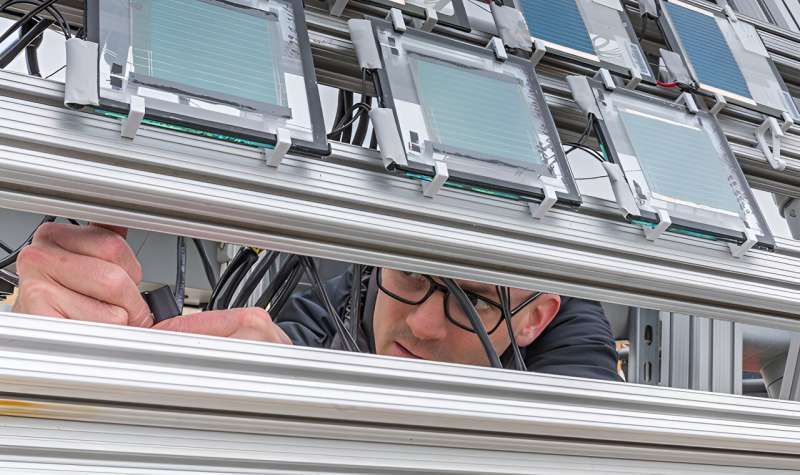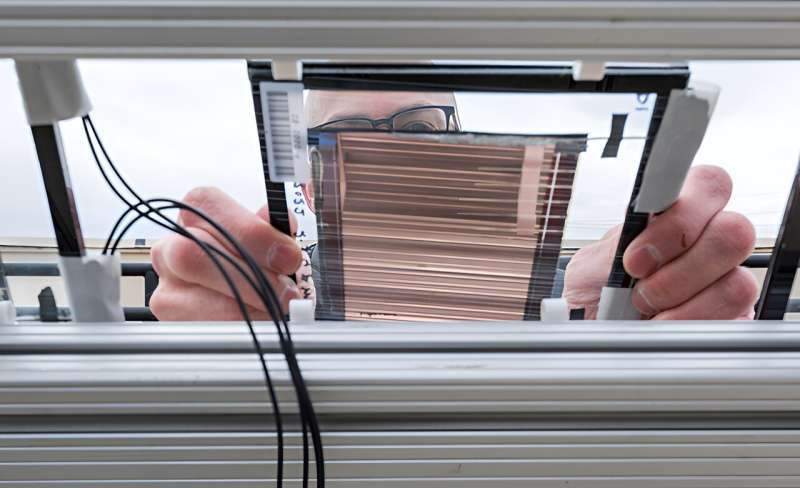This article has been reviewed according to Science X's editorial process and policies. Editors have highlighted the following attributes while ensuring the content's credibility:
fact-checked
peer-reviewed publication
trusted source
proofread
Escaping the lab into the sunlight: Research examines durability of outdoor perovskite solar cells

Perovskite solar cells (PSCs) are promising next-generation solar photovoltaic (PV) cells with high performance and low production costs compared to silicon. However, one of the primary challenges to widespread adoption of PSCs is stability and durability.
New research examines degradation mechanisms of PSCs under the unfiltered sunlight of the outdoors in comparison with widely used light-emitting diodes.
The research, titled "Strong-Bonding Hole-Transport Layers Reduce Ultraviolet Degradation of Perovskite Solar Cells," was published in Science and found that a special hybrid polymer material synthesized as part of this work and placed within the perovskite cell helped retain high efficiency and improved ultraviolet (UV) stability in outdoor testing.
The cross-country team of researchers for this study was led by the University of North Carolina at Chapel Hill with support from the Colorado School of Mines; National Renewable Energy Laboratory (NREL); University of California, San Diego; and University of Toledo.
A key component of this research was an independent verification of the results by U.S. Department of Energy's (DOE) Perovskite PV Accelerator for Commercializing Technologies (PACT) center.
Identifying reasons for perovskite durability between the lab and the outdoors
Most PSC testing occurs in the controlled environment of the lab using light-emitting diodes as light sources. To expedite PSC commercialization, real-world outdoor performance testing is needed to understand underlying mechanisms of sunlight and temperature degradation.
Outdoor conditions are different from indoor light-soaking or maximum power point tracking in several ways. Temperature, irradiance, and UV light intensity constantly change outdoors. Perovskite thin-films can decompose when they react with moisture and oxygen or when they spend extended time exposed to light, heat, or applied voltage.

The team investigated the mechanism of UV light-induced degradation in p-i-n structured PSCs with organic hybrid hole transport materials (HTMs) and developed a method to narrow the gap between indoor and outdoor durability.
In perovskite solar cells, an electric field separates and drives the electron-hole pairs generated from sunlight shining on the device out of the absorbing semiconductor material to generate electricity. The transport layer collects and moves electrons or holes from the perovskite layer to the electrodes, allowing for the flow of electricity.
The researchers determined that the weak chemical bonding between the perovskite layer, polymer HTM layer, and transparent conducting oxide (TCO) layer was found to dominate the degradation. This causes PSC degradation under sunlight with strong UV components.
Focusing on the weak chemical bond, researchers demonstrated that a synthesized polymer was found to strengthen the chemical bonding at the perovskite/HTM/TCO region.
This hybrid HTM layer was independently verified at the PACT center, and the champion module demonstrated an initial period where the operational efficiency increased a few percent to about 16%. After 29 weeks of outdoor testing, the operational efficiency remained over 16%.
Accelerating novel perovskite materials with PACT center testing and evaluation
In 2021, the DOE Solar Energy Technologies Office (SETO) established the PACT center to initiate testing and evaluation standards to assess and validate performance and reliability claims for fast-evolving perovskite PV technology.
"We believe this is the first published demonstration of outdoor performance showing perovskite mini modules with an area greater than 15 cm2 that had a measured aperture efficiency above 16% after 29 weeks of outdoor testing," said Laura Schelhas, NREL chemistry researcher, deputy director of PACT, and PACT reliability team lead.
"Real-world demonstration is a critical step towards commercialization, and we hope by PACT offering these capabilities researchers and companies can leverage this data toward improved reliability."
Providing testing protocols like those developed by the PACT center will help develop a fair and level playing field for the emerging perovskite PV industry.
More information: Chengbin Fei et al, Strong-bonding hole-transport layers reduce ultraviolet degradation of perovskite solar cells, Science (2024). DOI: 10.1126/science.adi4531


















